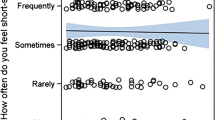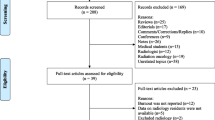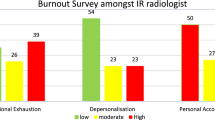Abstract
Background
A recent study showed a high prevalence of burnout in pediatric radiology.
Objective
The purpose of this study is to evaluate potential stressors contributing to burnout in pediatric radiology.
Materials and methods
Society for Pediatric Radiology members received an invitation for an anonymous survey evaluating stressors contributing to burnout. Stressors evaluated included call burden, financial stress, work-life balance, health care evolution and job market changes, and radiology as a career choice. Additional questions regarding demographics were obtained.
Results
The response rate was 460/1,453 (32%). The prevalence of emotional exhaustion was 66% (286/435), depersonalization was 61% (265/433) and perceived lack of personal accomplishment was 15% (67/436). In a backward selective logistic regression model, work-life imbalance and call burden were the only significant factors predicting higher emotional exhaustion (P<0.001). Using a similar model, work-life imbalance, call burden and decreased rate of reimbursement were significantly associated with higher probability of depersonalization (P=0.033, 0.0002 and 0.015, respectively). Emotional exhaustion and depersonalization were significantly associated with higher odds of a radiologist’s wish to work in another medical specialty (P=0.011 and 0.002, respectively).
Conclusion
Key stressors contributing to burnout in pediatric radiology include work-life imbalance, pediatric call burden and a decreased rate of reimbursement. Burnout in pediatric radiology is a serious issue that needs to be addressed and prioritized on the individual and departmental/institutional levels and further investigated to develop effective interventions to mitigate it.
Similar content being viewed by others
References
Maslach C, Schaufeli WB, Leiter MP (2001) Job burnout. Annu Rev Psychol 52:397–422
Maslach C, Jackson S (1981) The measurement of experienced burnout. J Occup Behav 2:99–113
Peckham C Medscape National Physician Burnout & Depression Report 2018. https://www.medscape.com/slideshow/2018-lifestyle-burnout-depression-6009235. Accessed 4 Dec 2018
Chew FS, Mulcahy MJ, Porrino JA et al (2017) Prevalence of burnout among musculoskeletal radiologists. Skeletal Radiol 46:497–506
Chen JY, Lexa FJ (2017) Baseline survey of the neuroradiology work environment in the United States with reported trends in clinical work, nonclinical work, perceptions of trainees, and burnout metrics. AJNR Am J Neuroradiol 38:1284–1291
Ayyala RS, Ahmed FS, Ruzal-Shapiro C, Taylor GA (2018) Prevalence of burnout among pediatric radiologists. J Am Coll Radiol. https://doi.org/10.1016/j.jacr.2018.08.016
Shanafelt TD, Hasan O, Dyrbye LN et al (2016) Changes in burnout and satisfaction with work-life balance in physicians and the general US working population between 2011 and 2014. Mayo Clin Proc 90:1600–1613
Porrino J, Mulcahy MJ, Mulcahy H et al (2017) Emotional wellness of current musculoskeletal radiology fellows. Acad Radiol 24:682–693
Kristensen TS, Borritz M, Villadsen E, Christensen KB (2005) The Copenhagen burnout inventory: a new tool for the assessment of burnout. Work and Stress 19:192–207
Halbesleben JRB, Demerouti E (2005) The construct validity of an alternative measure of burnout: investigating the English translation of the Oldenburg burnout inventory. Work and Stress 19:208–220
Demerouti E, Bakker AB, Vardakou I, Kantas A (2003) The convergent validity of two burnout instruments: A multitrait-multimethod analysis. Eur J Psychol Assess 19:12–23
Schaufeli WB, Taris TW (2005) The conceptualization and measurement of burnout: common ground and worlds apart. Work and Stress 19:256–262
Schaufeli WB, Leiter MP, Maslach C (2009) Burnout: 35 years of research and practice. Career Dev Int 14:204–220
West CP, Dyrbye LN, Sloan JA, Shanafelt TD (2009) Single item measures of emotional exhaustion and depersonalization are useful for assessing burnout in medical professionals. J Gen Intern Med 24:1318–1321
West CP, Dyrbye LN, Satele DV et al (2012) Concurrent validity of single-item measures of emotional exhaustion and depersonalization in burnout assessment. J Gen Intern Med 27:1445–1452
McNeeley MF, Perez FA, Chew FS (2013) The emotional wellness of radiology trainees: prevalence and predictors of burnout. Acad Radiol 20:647–655
Selenko E, Batinic B (2011) Beyond debt. A moderator analysis of the relationship between perceived financial strain and mental health. Soc Sci Med 73:1725–1732
Dyrbye LN, Shanafelt TD, Balch CM et al (2011) Relationship between work-home conflicts and burnout among American surgeons: a comparison by sex. Arch Surg 146:211–217
Pfeifer CM (2018) Declining interest in pediatric radiology prompts a call to action. J Am Coll Radiol 15:490–492
Shanafelt T, Sloan J, Satele D, Balch C (2011) Why do surgeons consider leaving practice? J Am Coll Surg 212:421–422
Shanafelt TD, Raymond M, Kosty M et al (2014) Satisfaction with work-life balance and the career and retirement plans of US oncologists. J Clin Oncol 32:1127–1135
Maslach C, Jackson S, Leiter M (1997) The Maslach burnout inventory manual, 4th edn. Consulting Psychologists Press, Palo Alto
Guenette JP, Smith SE (2017) Burnout: prevalence and associated factors among radiology residents in New England with comparison against United States resident physicians in other specialties. AJR Am J Roentgenol 209:136–141
Harolds JA, Parikh JR, Bluth EI et al (2016) Burnout of radiologists: frequency, risk factors, and remedies: a report of the ACR Commission on Human Resources. J Am Coll Radiol 13:411–416
Nicola R, McNeeley MF, Bhargava P (2015) Burnout in radiology. Curr Probl Diagn Radiol 44:389–390
Brown SD, Goske MJ, Johnson CM (2009) Beyond substance abuse: stress, burnout, and depression as causes of physician impairment and disruptive behavior. J Am Coll Radiol 6:479–485
Donaldson JS, Thakrar KH (2017) 24/7 pediatric radiology attending coverage: times are changing. Pediatr Radiol 47:803–807
Graham J, Ramirez AJ, Field S, Richards MA (2000) Job stress and satisfaction among clinical radiologists. Clin Radiol 55:182–185
McMurray JE, Linzer M, Konrad TR et al (2000) The work lives of women physicians: results from the physician work life study. J Gen Intern Med 15:372–380
McKevitt C, Morgan M, Dundas R, Holland WW (1997) Sickness absence and “working through” illness: a comparison of two professional groups. J Public Health Med 19:295–300
Chetlen AL, Chan TL, Ballard DH et al (2018) Addressing burnout in radiologists. Acad Radiol. https://doi.org/10.1016/j.acra.2018.07.001
Scheinfeld MH, Moon JY, Fagan MJ et al (2017) MRI usage in a pediatric emergency department: an analysis of usage and usage trends over 5 years. Pediatr Radiol 47:327–332
Levin DC, Parker L, Rao VM (2018) The percent share of all Medicare payments to physicians that is attributable to noninvasive diagnostic imaging. J Am Coll Radiol 15:721–725
Landon BE, Reschovsky J, Blumenthal D (2003) Changes in career satisfaction among primary care and specialist physicians, 1997–2001. JAMA 289:442–449
Sinsky CA, Dyrbye LN, West CP et al (2017) Professional satisfaction and the career plans of US physicians. Mayo Clin Proc 92:1625–1635
Keeble C, Law GR, Barber S, Baxter PD (2015) Choosing a method to reduce selection bias: a tool for researchers. Open J Epidemiol 05:155–162
Merewitz L, Sunshine JH (2006) A portrait of pediatric radiologists in the United States. AJR Am J Roentgenol 186:12–22
Panagioti M, Panagopoulou E, Bower P et al (2017) Controlled interventions to reduce burnout in physicians a systematic review and meta-analysis. JAMA Intern Med 177:195–205
Bluth EI, Bender CE, Parikh JR (2017) Burnout: redesign the work process rather than the person. J Am Coll Radiol 14:1375–1376
Kruskal JB, Shanafelt T, Eby P et al (2018) A road map to foster wellness and engagement in our workplace—a report of the 2018 Summer Intersociety Meeting. J Am Coll Radiol https://doi.org/10.1016/j.jacr.2018.10.025
Author information
Authors and Affiliations
Corresponding author
Ethics declarations
Conflicts of interest
None
Additional information
Publisher’s note
Springer Nature remains neutral with regard to jurisdictional claims in published maps and institutional affiliations.
Rights and permissions
About this article
Cite this article
Ayyala, R.S., Ahmed, F.S., Ruzal-Shapiro, C. et al. Stressors contributing to burnout amongst pediatric radiologists: results from a survey of the Society for Pediatric Radiology. Pediatr Radiol 49, 714–722 (2019). https://doi.org/10.1007/s00247-019-04370-z
Received:
Revised:
Accepted:
Published:
Issue Date:
DOI: https://doi.org/10.1007/s00247-019-04370-z




